Financial Accounting Theory Report: Analysis and Discussion
VerifiedAdded on 2022/10/06
|14
|3577
|284
Report
AI Summary
This report provides a comprehensive analysis of financial accounting theory, addressing key aspects such as the conceptual framework, measurement bases, and the objectives of financial reporting. The report begins by examining the benefits of the conceptual framework, the strategic role it plays for standard-setting bodies, and the groups that benefit from its development. It then delves into the objectives of general-purpose financial reporting, focusing on the needs of investors, lenders, and creditors. The report also explores various measurement bases, including historical cost and fair value, and discusses their relevance and qualitative characteristics as per the AASB Framework. Finally, it examines historical cost accounting, its advantages, disadvantages, and its role in financial reporting. The report references various academic sources to support its arguments and provides a well-rounded overview of the subject matter.

Running head: FINANCIAL ACCOUNTING THEORY
Financial Accounting Theory
Name of the Student
Name of the University
Author’s Note
Financial Accounting Theory
Name of the Student
Name of the University
Author’s Note
Paraphrase This Document
Need a fresh take? Get an instant paraphrase of this document with our AI Paraphraser
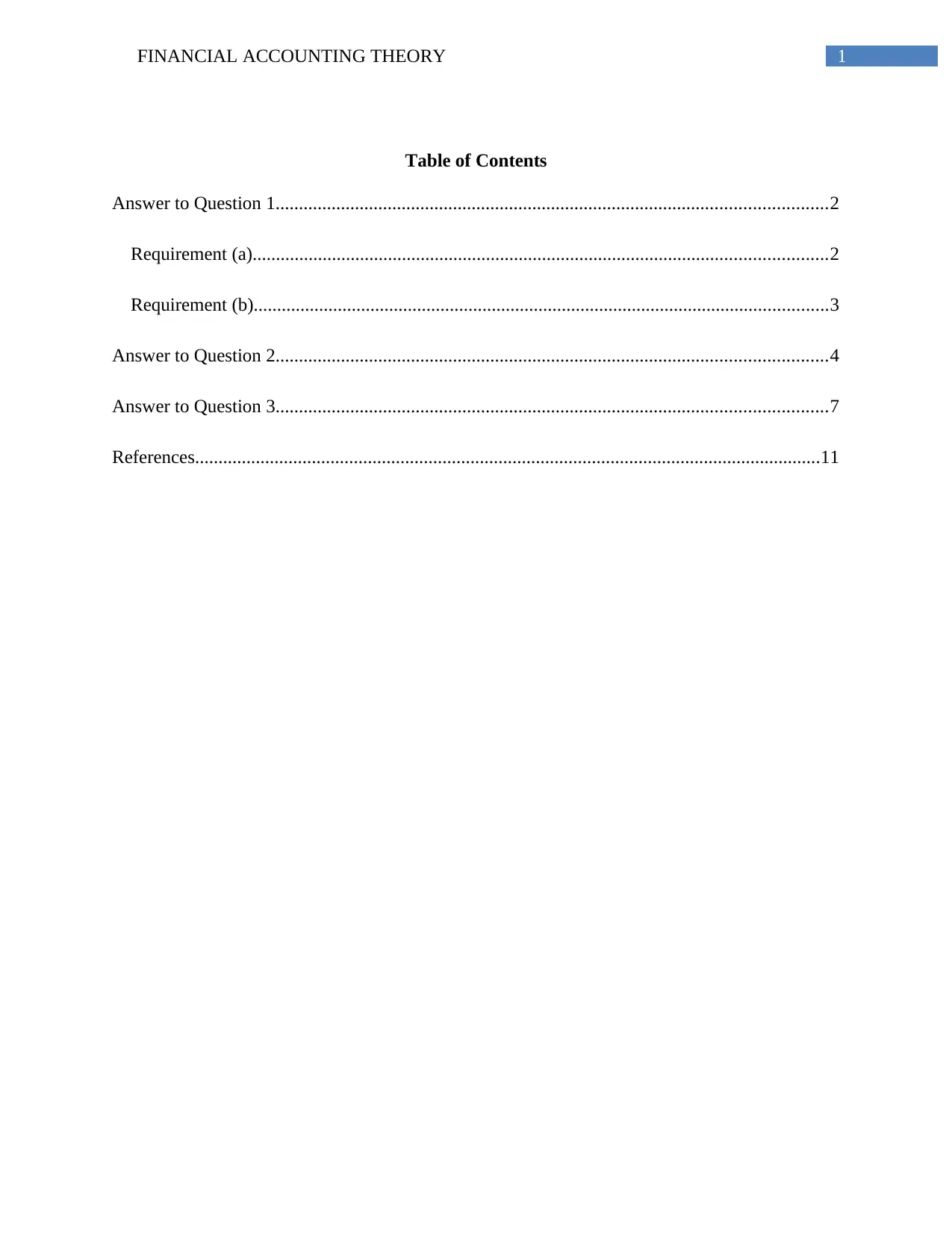
1FINANCIAL ACCOUNTING THEORY
Table of Contents
Answer to Question 1......................................................................................................................2
Requirement (a)...........................................................................................................................2
Requirement (b)...........................................................................................................................3
Answer to Question 2......................................................................................................................4
Answer to Question 3......................................................................................................................7
References......................................................................................................................................11
Table of Contents
Answer to Question 1......................................................................................................................2
Requirement (a)...........................................................................................................................2
Requirement (b)...........................................................................................................................3
Answer to Question 2......................................................................................................................4
Answer to Question 3......................................................................................................................7
References......................................................................................................................................11
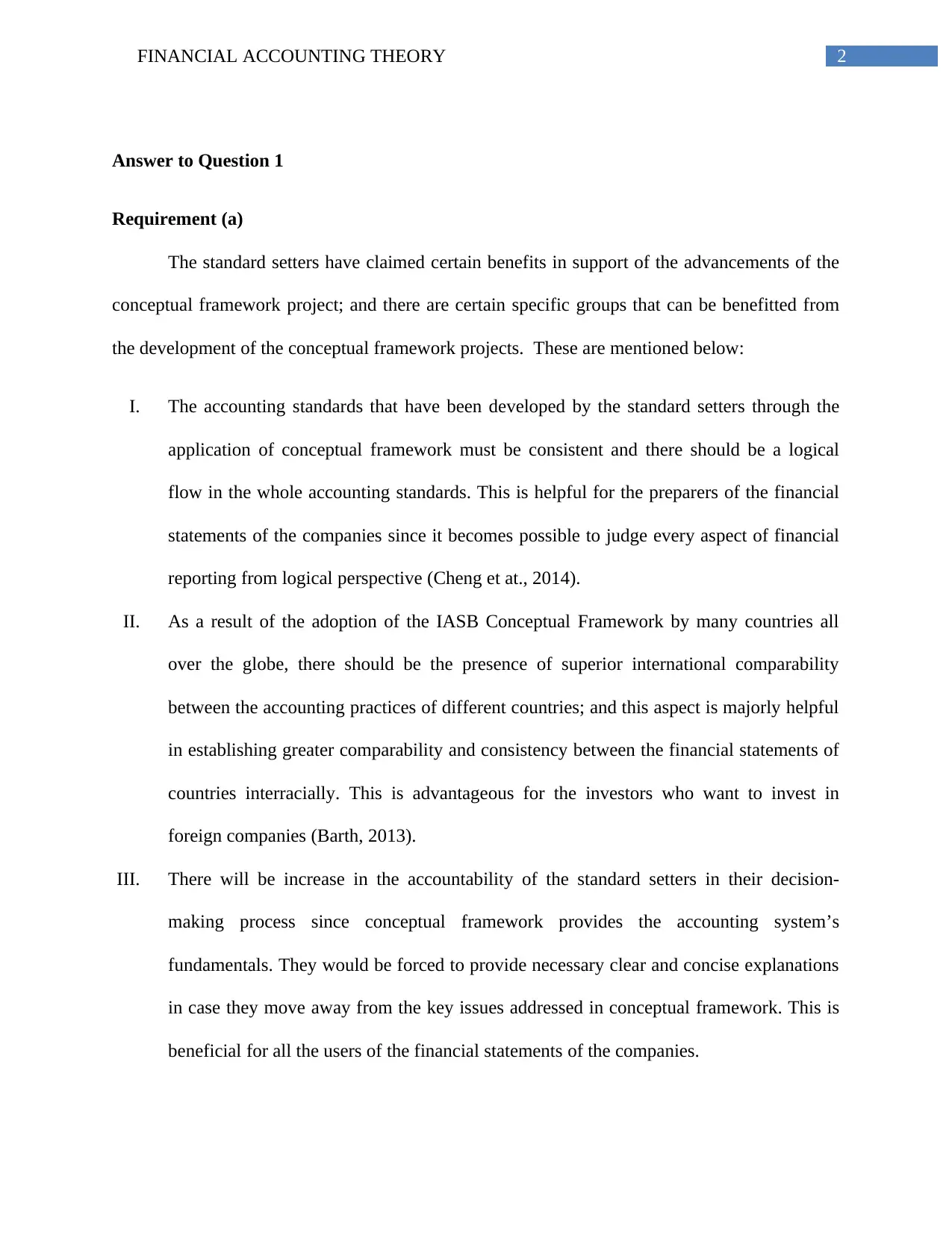
2FINANCIAL ACCOUNTING THEORY
Answer to Question 1
Requirement (a)
The standard setters have claimed certain benefits in support of the advancements of the
conceptual framework project; and there are certain specific groups that can be benefitted from
the development of the conceptual framework projects. These are mentioned below:
I. The accounting standards that have been developed by the standard setters through the
application of conceptual framework must be consistent and there should be a logical
flow in the whole accounting standards. This is helpful for the preparers of the financial
statements of the companies since it becomes possible to judge every aspect of financial
reporting from logical perspective (Cheng et at., 2014).
II. As a result of the adoption of the IASB Conceptual Framework by many countries all
over the globe, there should be the presence of superior international comparability
between the accounting practices of different countries; and this aspect is majorly helpful
in establishing greater comparability and consistency between the financial statements of
countries interracially. This is advantageous for the investors who want to invest in
foreign companies (Barth, 2013).
III. There will be increase in the accountability of the standard setters in their decision-
making process since conceptual framework provides the accounting system’s
fundamentals. They would be forced to provide necessary clear and concise explanations
in case they move away from the key issues addressed in conceptual framework. This is
beneficial for all the users of the financial statements of the companies.
Answer to Question 1
Requirement (a)
The standard setters have claimed certain benefits in support of the advancements of the
conceptual framework project; and there are certain specific groups that can be benefitted from
the development of the conceptual framework projects. These are mentioned below:
I. The accounting standards that have been developed by the standard setters through the
application of conceptual framework must be consistent and there should be a logical
flow in the whole accounting standards. This is helpful for the preparers of the financial
statements of the companies since it becomes possible to judge every aspect of financial
reporting from logical perspective (Cheng et at., 2014).
II. As a result of the adoption of the IASB Conceptual Framework by many countries all
over the globe, there should be the presence of superior international comparability
between the accounting practices of different countries; and this aspect is majorly helpful
in establishing greater comparability and consistency between the financial statements of
countries interracially. This is advantageous for the investors who want to invest in
foreign companies (Barth, 2013).
III. There will be increase in the accountability of the standard setters in their decision-
making process since conceptual framework provides the accounting system’s
fundamentals. They would be forced to provide necessary clear and concise explanations
in case they move away from the key issues addressed in conceptual framework. This is
beneficial for all the users of the financial statements of the companies.
⊘ This is a preview!⊘
Do you want full access?
Subscribe today to unlock all pages.

Trusted by 1+ million students worldwide
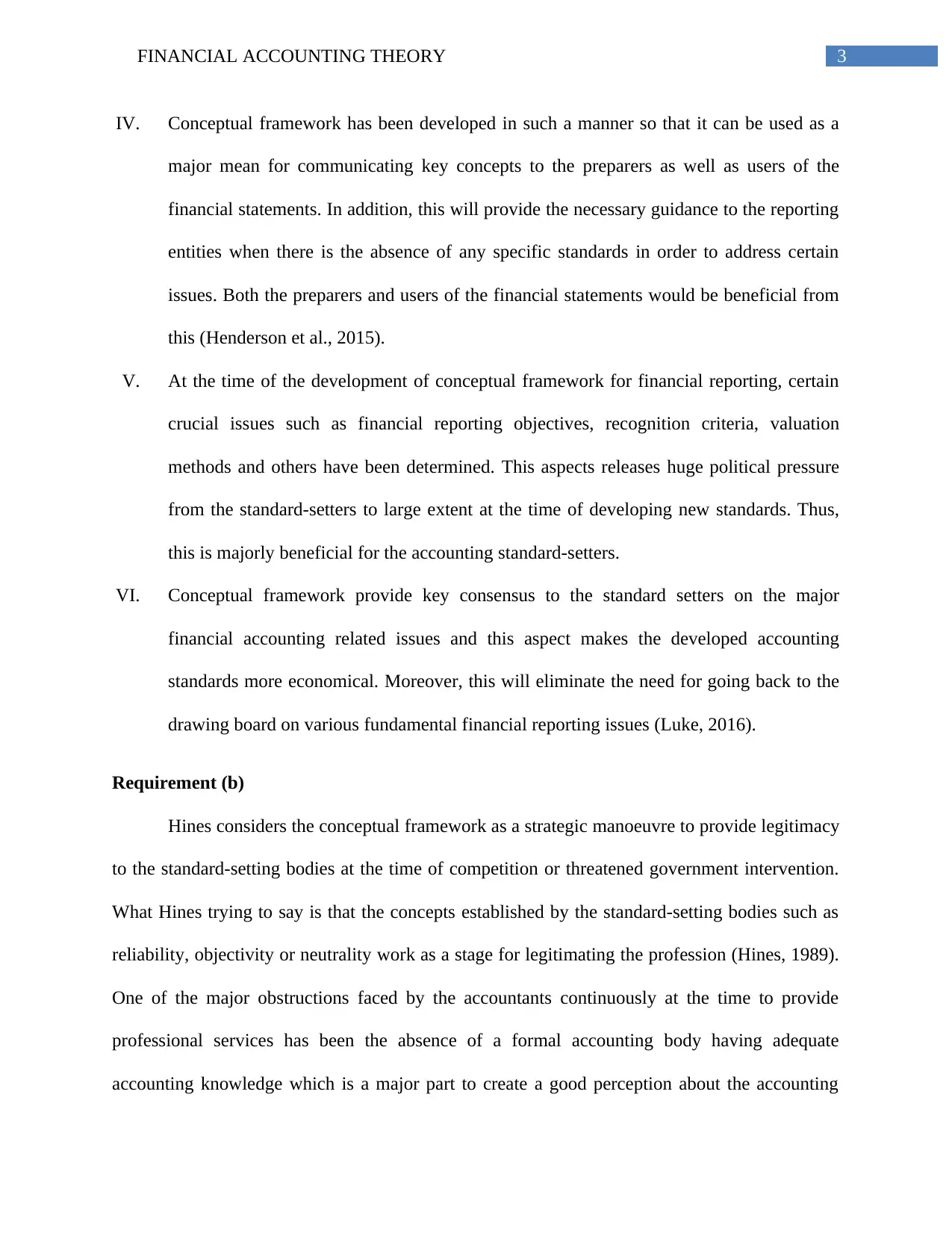
3FINANCIAL ACCOUNTING THEORY
IV. Conceptual framework has been developed in such a manner so that it can be used as a
major mean for communicating key concepts to the preparers as well as users of the
financial statements. In addition, this will provide the necessary guidance to the reporting
entities when there is the absence of any specific standards in order to address certain
issues. Both the preparers and users of the financial statements would be beneficial from
this (Henderson et al., 2015).
V. At the time of the development of conceptual framework for financial reporting, certain
crucial issues such as financial reporting objectives, recognition criteria, valuation
methods and others have been determined. This aspects releases huge political pressure
from the standard-setters to large extent at the time of developing new standards. Thus,
this is majorly beneficial for the accounting standard-setters.
VI. Conceptual framework provide key consensus to the standard setters on the major
financial accounting related issues and this aspect makes the developed accounting
standards more economical. Moreover, this will eliminate the need for going back to the
drawing board on various fundamental financial reporting issues (Luke, 2016).
Requirement (b)
Hines considers the conceptual framework as a strategic manoeuvre to provide legitimacy
to the standard-setting bodies at the time of competition or threatened government intervention.
What Hines trying to say is that the concepts established by the standard-setting bodies such as
reliability, objectivity or neutrality work as a stage for legitimating the profession (Hines, 1989).
One of the major obstructions faced by the accountants continuously at the time to provide
professional services has been the absence of a formal accounting body having adequate
accounting knowledge which is a major part to create a good perception about the accounting
IV. Conceptual framework has been developed in such a manner so that it can be used as a
major mean for communicating key concepts to the preparers as well as users of the
financial statements. In addition, this will provide the necessary guidance to the reporting
entities when there is the absence of any specific standards in order to address certain
issues. Both the preparers and users of the financial statements would be beneficial from
this (Henderson et al., 2015).
V. At the time of the development of conceptual framework for financial reporting, certain
crucial issues such as financial reporting objectives, recognition criteria, valuation
methods and others have been determined. This aspects releases huge political pressure
from the standard-setters to large extent at the time of developing new standards. Thus,
this is majorly beneficial for the accounting standard-setters.
VI. Conceptual framework provide key consensus to the standard setters on the major
financial accounting related issues and this aspect makes the developed accounting
standards more economical. Moreover, this will eliminate the need for going back to the
drawing board on various fundamental financial reporting issues (Luke, 2016).
Requirement (b)
Hines considers the conceptual framework as a strategic manoeuvre to provide legitimacy
to the standard-setting bodies at the time of competition or threatened government intervention.
What Hines trying to say is that the concepts established by the standard-setting bodies such as
reliability, objectivity or neutrality work as a stage for legitimating the profession (Hines, 1989).
One of the major obstructions faced by the accountants continuously at the time to provide
professional services has been the absence of a formal accounting body having adequate
accounting knowledge which is a major part to create a good perception about the accounting
Paraphrase This Document
Need a fresh take? Get an instant paraphrase of this document with our AI Paraphraser
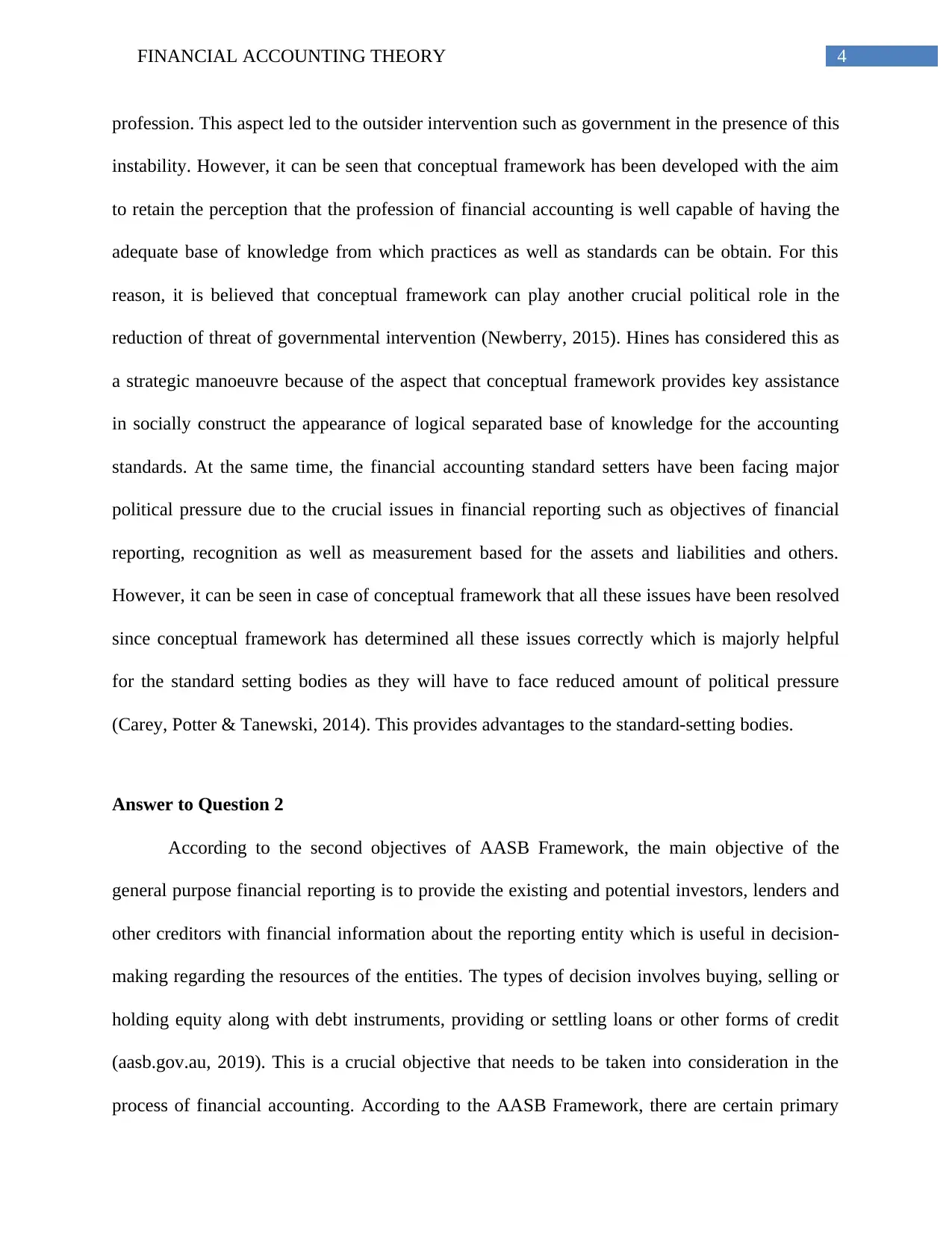
4FINANCIAL ACCOUNTING THEORY
profession. This aspect led to the outsider intervention such as government in the presence of this
instability. However, it can be seen that conceptual framework has been developed with the aim
to retain the perception that the profession of financial accounting is well capable of having the
adequate base of knowledge from which practices as well as standards can be obtain. For this
reason, it is believed that conceptual framework can play another crucial political role in the
reduction of threat of governmental intervention (Newberry, 2015). Hines has considered this as
a strategic manoeuvre because of the aspect that conceptual framework provides key assistance
in socially construct the appearance of logical separated base of knowledge for the accounting
standards. At the same time, the financial accounting standard setters have been facing major
political pressure due to the crucial issues in financial reporting such as objectives of financial
reporting, recognition as well as measurement based for the assets and liabilities and others.
However, it can be seen in case of conceptual framework that all these issues have been resolved
since conceptual framework has determined all these issues correctly which is majorly helpful
for the standard setting bodies as they will have to face reduced amount of political pressure
(Carey, Potter & Tanewski, 2014). This provides advantages to the standard-setting bodies.
Answer to Question 2
According to the second objectives of AASB Framework, the main objective of the
general purpose financial reporting is to provide the existing and potential investors, lenders and
other creditors with financial information about the reporting entity which is useful in decision-
making regarding the resources of the entities. The types of decision involves buying, selling or
holding equity along with debt instruments, providing or settling loans or other forms of credit
(aasb.gov.au, 2019). This is a crucial objective that needs to be taken into consideration in the
process of financial accounting. According to the AASB Framework, there are certain primary
profession. This aspect led to the outsider intervention such as government in the presence of this
instability. However, it can be seen that conceptual framework has been developed with the aim
to retain the perception that the profession of financial accounting is well capable of having the
adequate base of knowledge from which practices as well as standards can be obtain. For this
reason, it is believed that conceptual framework can play another crucial political role in the
reduction of threat of governmental intervention (Newberry, 2015). Hines has considered this as
a strategic manoeuvre because of the aspect that conceptual framework provides key assistance
in socially construct the appearance of logical separated base of knowledge for the accounting
standards. At the same time, the financial accounting standard setters have been facing major
political pressure due to the crucial issues in financial reporting such as objectives of financial
reporting, recognition as well as measurement based for the assets and liabilities and others.
However, it can be seen in case of conceptual framework that all these issues have been resolved
since conceptual framework has determined all these issues correctly which is majorly helpful
for the standard setting bodies as they will have to face reduced amount of political pressure
(Carey, Potter & Tanewski, 2014). This provides advantages to the standard-setting bodies.
Answer to Question 2
According to the second objectives of AASB Framework, the main objective of the
general purpose financial reporting is to provide the existing and potential investors, lenders and
other creditors with financial information about the reporting entity which is useful in decision-
making regarding the resources of the entities. The types of decision involves buying, selling or
holding equity along with debt instruments, providing or settling loans or other forms of credit
(aasb.gov.au, 2019). This is a crucial objective that needs to be taken into consideration in the
process of financial accounting. According to the AASB Framework, there are certain primary
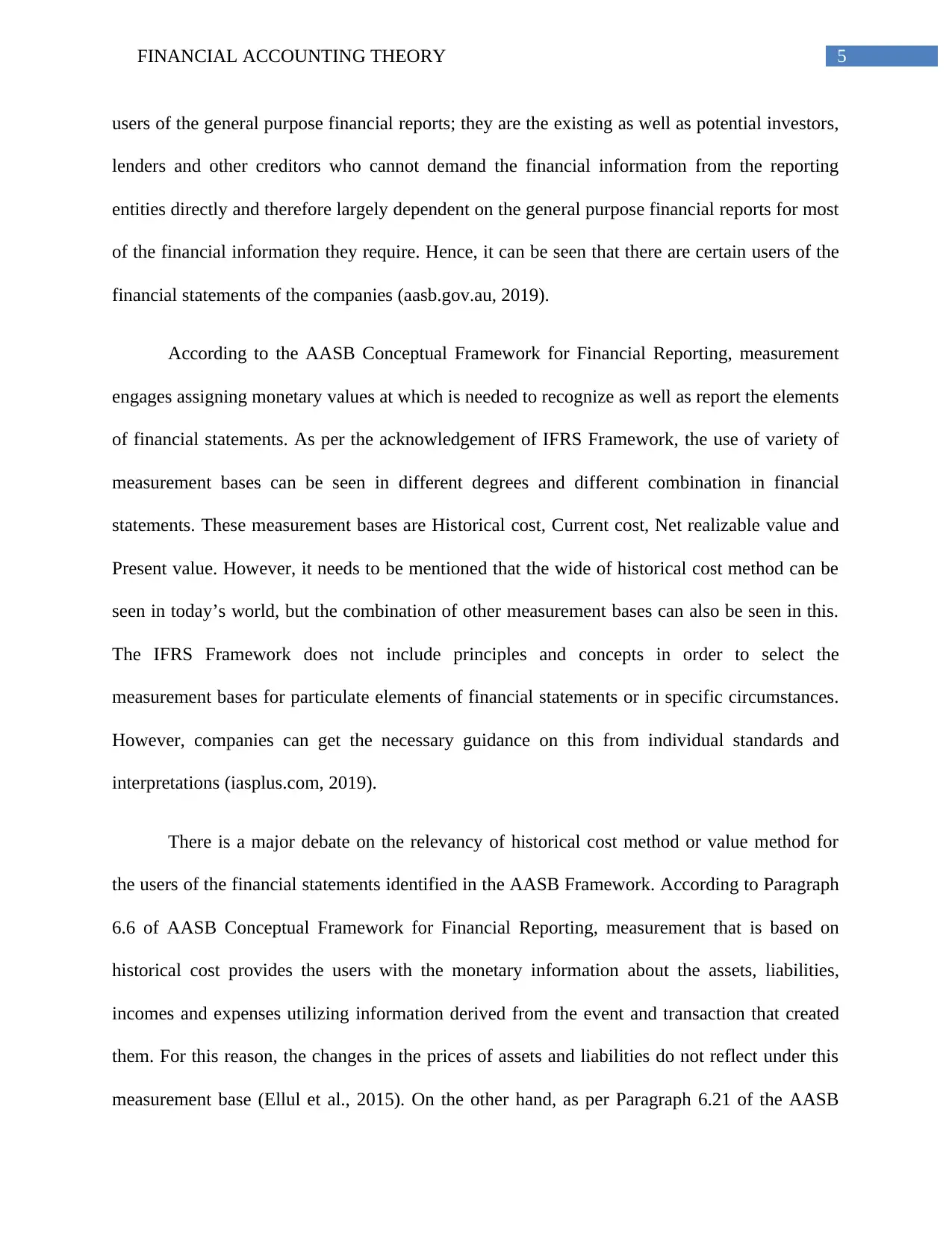
5FINANCIAL ACCOUNTING THEORY
users of the general purpose financial reports; they are the existing as well as potential investors,
lenders and other creditors who cannot demand the financial information from the reporting
entities directly and therefore largely dependent on the general purpose financial reports for most
of the financial information they require. Hence, it can be seen that there are certain users of the
financial statements of the companies (aasb.gov.au, 2019).
According to the AASB Conceptual Framework for Financial Reporting, measurement
engages assigning monetary values at which is needed to recognize as well as report the elements
of financial statements. As per the acknowledgement of IFRS Framework, the use of variety of
measurement bases can be seen in different degrees and different combination in financial
statements. These measurement bases are Historical cost, Current cost, Net realizable value and
Present value. However, it needs to be mentioned that the wide of historical cost method can be
seen in today’s world, but the combination of other measurement bases can also be seen in this.
The IFRS Framework does not include principles and concepts in order to select the
measurement bases for particulate elements of financial statements or in specific circumstances.
However, companies can get the necessary guidance on this from individual standards and
interpretations (iasplus.com, 2019).
There is a major debate on the relevancy of historical cost method or value method for
the users of the financial statements identified in the AASB Framework. According to Paragraph
6.6 of AASB Conceptual Framework for Financial Reporting, measurement that is based on
historical cost provides the users with the monetary information about the assets, liabilities,
incomes and expenses utilizing information derived from the event and transaction that created
them. For this reason, the changes in the prices of assets and liabilities do not reflect under this
measurement base (Ellul et al., 2015). On the other hand, as per Paragraph 6.21 of the AASB
users of the general purpose financial reports; they are the existing as well as potential investors,
lenders and other creditors who cannot demand the financial information from the reporting
entities directly and therefore largely dependent on the general purpose financial reports for most
of the financial information they require. Hence, it can be seen that there are certain users of the
financial statements of the companies (aasb.gov.au, 2019).
According to the AASB Conceptual Framework for Financial Reporting, measurement
engages assigning monetary values at which is needed to recognize as well as report the elements
of financial statements. As per the acknowledgement of IFRS Framework, the use of variety of
measurement bases can be seen in different degrees and different combination in financial
statements. These measurement bases are Historical cost, Current cost, Net realizable value and
Present value. However, it needs to be mentioned that the wide of historical cost method can be
seen in today’s world, but the combination of other measurement bases can also be seen in this.
The IFRS Framework does not include principles and concepts in order to select the
measurement bases for particulate elements of financial statements or in specific circumstances.
However, companies can get the necessary guidance on this from individual standards and
interpretations (iasplus.com, 2019).
There is a major debate on the relevancy of historical cost method or value method for
the users of the financial statements identified in the AASB Framework. According to Paragraph
6.6 of AASB Conceptual Framework for Financial Reporting, measurement that is based on
historical cost provides the users with the monetary information about the assets, liabilities,
incomes and expenses utilizing information derived from the event and transaction that created
them. For this reason, the changes in the prices of assets and liabilities do not reflect under this
measurement base (Ellul et al., 2015). On the other hand, as per Paragraph 6.21 of the AASB
⊘ This is a preview!⊘
Do you want full access?
Subscribe today to unlock all pages.

Trusted by 1+ million students worldwide
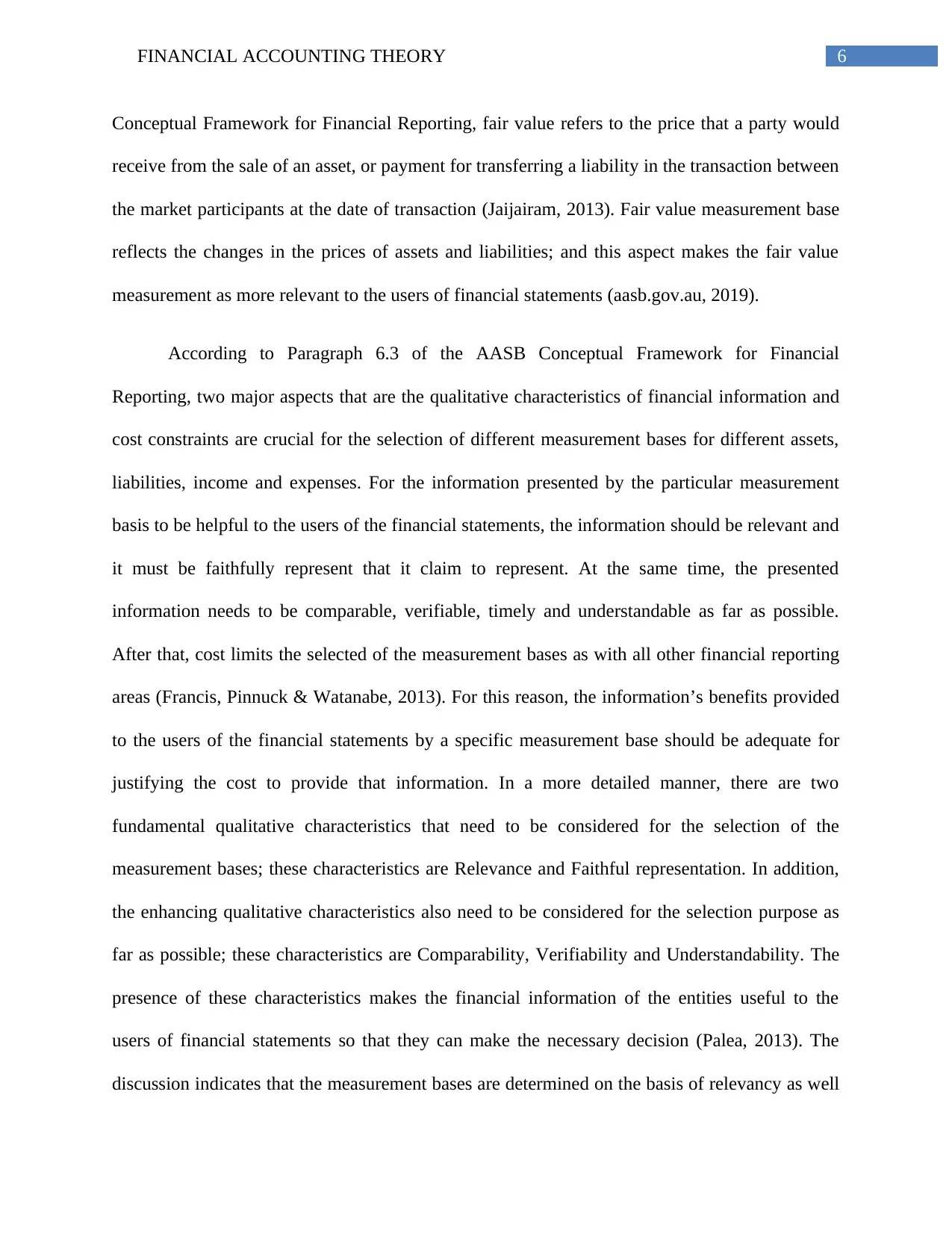
6FINANCIAL ACCOUNTING THEORY
Conceptual Framework for Financial Reporting, fair value refers to the price that a party would
receive from the sale of an asset, or payment for transferring a liability in the transaction between
the market participants at the date of transaction (Jaijairam, 2013). Fair value measurement base
reflects the changes in the prices of assets and liabilities; and this aspect makes the fair value
measurement as more relevant to the users of financial statements (aasb.gov.au, 2019).
According to Paragraph 6.3 of the AASB Conceptual Framework for Financial
Reporting, two major aspects that are the qualitative characteristics of financial information and
cost constraints are crucial for the selection of different measurement bases for different assets,
liabilities, income and expenses. For the information presented by the particular measurement
basis to be helpful to the users of the financial statements, the information should be relevant and
it must be faithfully represent that it claim to represent. At the same time, the presented
information needs to be comparable, verifiable, timely and understandable as far as possible.
After that, cost limits the selected of the measurement bases as with all other financial reporting
areas (Francis, Pinnuck & Watanabe, 2013). For this reason, the information’s benefits provided
to the users of the financial statements by a specific measurement base should be adequate for
justifying the cost to provide that information. In a more detailed manner, there are two
fundamental qualitative characteristics that need to be considered for the selection of the
measurement bases; these characteristics are Relevance and Faithful representation. In addition,
the enhancing qualitative characteristics also need to be considered for the selection purpose as
far as possible; these characteristics are Comparability, Verifiability and Understandability. The
presence of these characteristics makes the financial information of the entities useful to the
users of financial statements so that they can make the necessary decision (Palea, 2013). The
discussion indicates that the measurement bases are determined on the basis of relevancy as well
Conceptual Framework for Financial Reporting, fair value refers to the price that a party would
receive from the sale of an asset, or payment for transferring a liability in the transaction between
the market participants at the date of transaction (Jaijairam, 2013). Fair value measurement base
reflects the changes in the prices of assets and liabilities; and this aspect makes the fair value
measurement as more relevant to the users of financial statements (aasb.gov.au, 2019).
According to Paragraph 6.3 of the AASB Conceptual Framework for Financial
Reporting, two major aspects that are the qualitative characteristics of financial information and
cost constraints are crucial for the selection of different measurement bases for different assets,
liabilities, income and expenses. For the information presented by the particular measurement
basis to be helpful to the users of the financial statements, the information should be relevant and
it must be faithfully represent that it claim to represent. At the same time, the presented
information needs to be comparable, verifiable, timely and understandable as far as possible.
After that, cost limits the selected of the measurement bases as with all other financial reporting
areas (Francis, Pinnuck & Watanabe, 2013). For this reason, the information’s benefits provided
to the users of the financial statements by a specific measurement base should be adequate for
justifying the cost to provide that information. In a more detailed manner, there are two
fundamental qualitative characteristics that need to be considered for the selection of the
measurement bases; these characteristics are Relevance and Faithful representation. In addition,
the enhancing qualitative characteristics also need to be considered for the selection purpose as
far as possible; these characteristics are Comparability, Verifiability and Understandability. The
presence of these characteristics makes the financial information of the entities useful to the
users of financial statements so that they can make the necessary decision (Palea, 2013). The
discussion indicates that the measurement bases are determined on the basis of relevancy as well
Paraphrase This Document
Need a fresh take? Get an instant paraphrase of this document with our AI Paraphraser
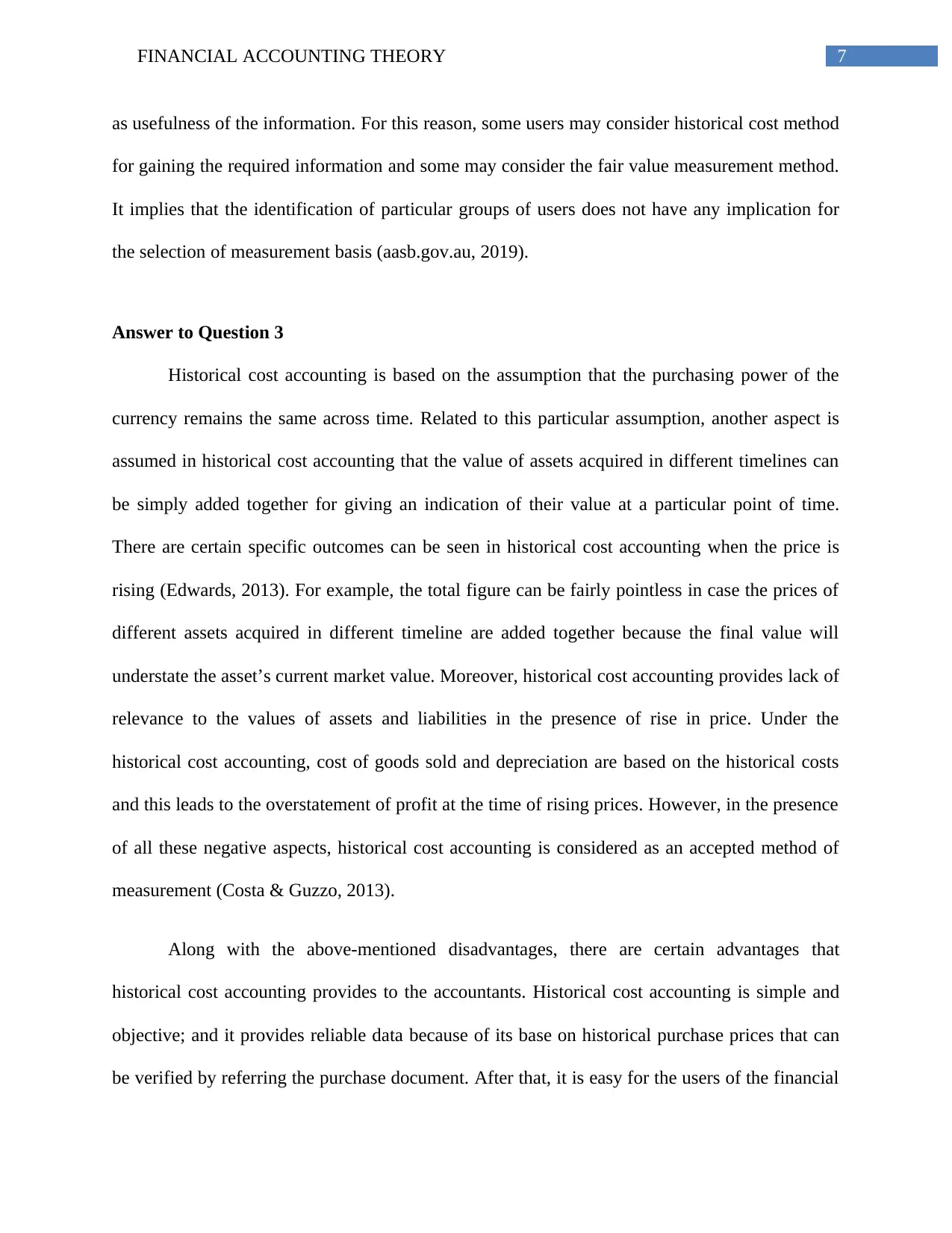
7FINANCIAL ACCOUNTING THEORY
as usefulness of the information. For this reason, some users may consider historical cost method
for gaining the required information and some may consider the fair value measurement method.
It implies that the identification of particular groups of users does not have any implication for
the selection of measurement basis (aasb.gov.au, 2019).
Answer to Question 3
Historical cost accounting is based on the assumption that the purchasing power of the
currency remains the same across time. Related to this particular assumption, another aspect is
assumed in historical cost accounting that the value of assets acquired in different timelines can
be simply added together for giving an indication of their value at a particular point of time.
There are certain specific outcomes can be seen in historical cost accounting when the price is
rising (Edwards, 2013). For example, the total figure can be fairly pointless in case the prices of
different assets acquired in different timeline are added together because the final value will
understate the asset’s current market value. Moreover, historical cost accounting provides lack of
relevance to the values of assets and liabilities in the presence of rise in price. Under the
historical cost accounting, cost of goods sold and depreciation are based on the historical costs
and this leads to the overstatement of profit at the time of rising prices. However, in the presence
of all these negative aspects, historical cost accounting is considered as an accepted method of
measurement (Costa & Guzzo, 2013).
Along with the above-mentioned disadvantages, there are certain advantages that
historical cost accounting provides to the accountants. Historical cost accounting is simple and
objective; and it provides reliable data because of its base on historical purchase prices that can
be verified by referring the purchase document. After that, it is easy for the users of the financial
as usefulness of the information. For this reason, some users may consider historical cost method
for gaining the required information and some may consider the fair value measurement method.
It implies that the identification of particular groups of users does not have any implication for
the selection of measurement basis (aasb.gov.au, 2019).
Answer to Question 3
Historical cost accounting is based on the assumption that the purchasing power of the
currency remains the same across time. Related to this particular assumption, another aspect is
assumed in historical cost accounting that the value of assets acquired in different timelines can
be simply added together for giving an indication of their value at a particular point of time.
There are certain specific outcomes can be seen in historical cost accounting when the price is
rising (Edwards, 2013). For example, the total figure can be fairly pointless in case the prices of
different assets acquired in different timeline are added together because the final value will
understate the asset’s current market value. Moreover, historical cost accounting provides lack of
relevance to the values of assets and liabilities in the presence of rise in price. Under the
historical cost accounting, cost of goods sold and depreciation are based on the historical costs
and this leads to the overstatement of profit at the time of rising prices. However, in the presence
of all these negative aspects, historical cost accounting is considered as an accepted method of
measurement (Costa & Guzzo, 2013).
Along with the above-mentioned disadvantages, there are certain advantages that
historical cost accounting provides to the accountants. Historical cost accounting is simple and
objective; and it provides reliable data because of its base on historical purchase prices that can
be verified by referring the purchase document. After that, it is easy for the users of the financial

8FINANCIAL ACCOUNTING THEORY
statements to understand as well as interpret financial reports based on historical cost accounting
as it is simple and relevant (Whittington, 2016). Financial information obtained from the
historical cost accounting has great demand in such markets where there is not any greater
demand of price level adjusted information. Large acceptance of historical cost accounting can
be seen all over the globe and therefore, this does not contribute towards huge changes in the
existing accounting practice. One major benefit of historical cost accounting is that the users of
the financial statements can know about the actual original value of assets and liabilities in the
financial statements due to the fact that there is not any requirement for adjustments. Moreover,
this is less complicated because of the fact that there is less room for accounting estimates as
well as assumptions. These can be considered as the major merits of historical cost accounting
(Tayeh, Al-Jarrah & Tarhini, 2015).
Certain alternative methods of measurement have been developed as the replacement of
historical cost accounting; they are Current Cost Accounting (CCA), Constant Purchasing Power
Accounting (CPPA) and Continuously Contemporary Accounting (CoCoa). Apart from
advantages of these techniques, there are certain major disadvantages that restricts people in
using these measurement based. In case of CPPA, its main disadvantage is that it does not show
the current value of assets and liabilities and it fails in capturing the economic substance when
there is divergence in specific and general price movements (Unegbu, 2014). On the other hand,
CCA is a complex process and the accountants have lack of familiarity with this measurement
base. It has a potential of greater subjectivity along with lower reliability. Most importantly,
CCA only adjusts the value of non-monetary assets, not all assets and liabilities (Reid, 2018).
Lastly, CoCoA is considered as a costly accounting system to maintain because of the cost to
obtain current net selling process of the assets at every reporting date. Moreover, the current
statements to understand as well as interpret financial reports based on historical cost accounting
as it is simple and relevant (Whittington, 2016). Financial information obtained from the
historical cost accounting has great demand in such markets where there is not any greater
demand of price level adjusted information. Large acceptance of historical cost accounting can
be seen all over the globe and therefore, this does not contribute towards huge changes in the
existing accounting practice. One major benefit of historical cost accounting is that the users of
the financial statements can know about the actual original value of assets and liabilities in the
financial statements due to the fact that there is not any requirement for adjustments. Moreover,
this is less complicated because of the fact that there is less room for accounting estimates as
well as assumptions. These can be considered as the major merits of historical cost accounting
(Tayeh, Al-Jarrah & Tarhini, 2015).
Certain alternative methods of measurement have been developed as the replacement of
historical cost accounting; they are Current Cost Accounting (CCA), Constant Purchasing Power
Accounting (CPPA) and Continuously Contemporary Accounting (CoCoa). Apart from
advantages of these techniques, there are certain major disadvantages that restricts people in
using these measurement based. In case of CPPA, its main disadvantage is that it does not show
the current value of assets and liabilities and it fails in capturing the economic substance when
there is divergence in specific and general price movements (Unegbu, 2014). On the other hand,
CCA is a complex process and the accountants have lack of familiarity with this measurement
base. It has a potential of greater subjectivity along with lower reliability. Most importantly,
CCA only adjusts the value of non-monetary assets, not all assets and liabilities (Reid, 2018).
Lastly, CoCoA is considered as a costly accounting system to maintain because of the cost to
obtain current net selling process of the assets at every reporting date. Moreover, the current
⊘ This is a preview!⊘
Do you want full access?
Subscribe today to unlock all pages.

Trusted by 1+ million students worldwide

9FINANCIAL ACCOUNTING THEORY
realizable value or net selling prices of the assets are not relevant in this method in case the entity
has no intention to sell its assets (Gaffikin, 2014). All these disadvantages of these alternative
costing systems of historical cost accounting push the managers towards the use of historical cost
accounting.
Apart from these merits, there are other aspects to consider when measuring the
popularity of historical cost accounting; and these can be seen in terms of considerations of the
organizational managers. The presence of two perspectives can be seen in this case; they are
efficiency perspective and opportunistic perspective. From the efficiency perspective, financial
managers of the companies might consider the fact that a more objective measure can be
obtained from historical cost accounting regarding an item and this can be considered as
preferable in order to display effective stewardship over the contributed resources to a reporting
entity (Magnan, Menini & Parbonetti, 2015). The managers might also take into consideration
the aspect that the other measurement bases apart from historical cost accounting such as market
values provide them with less reliable or relevant information. For instance, maybe these
reporting entities operate in such business industry that has high instability in the value of the
assets; and therefore, the organizational managers might consider the fact that in case the
valuation of the assets is done on the fluctuating market values, the there might be development
of confusion in the minds of the users of financial statements. This is an essential aspect to
consider. According to the opportunistic perspective, the organizational managers might take
into consideration the retention of the utilization of historical cost accounting because of the
aspect that this can allow them in profit manipulation through determination of the time to sell an
asset that has value appreciation; and they do not acknowledge this appreciation until the sale of
the asset. There will be full recognition of accumulated gain in the period of sale (Ellul et al.,
realizable value or net selling prices of the assets are not relevant in this method in case the entity
has no intention to sell its assets (Gaffikin, 2014). All these disadvantages of these alternative
costing systems of historical cost accounting push the managers towards the use of historical cost
accounting.
Apart from these merits, there are other aspects to consider when measuring the
popularity of historical cost accounting; and these can be seen in terms of considerations of the
organizational managers. The presence of two perspectives can be seen in this case; they are
efficiency perspective and opportunistic perspective. From the efficiency perspective, financial
managers of the companies might consider the fact that a more objective measure can be
obtained from historical cost accounting regarding an item and this can be considered as
preferable in order to display effective stewardship over the contributed resources to a reporting
entity (Magnan, Menini & Parbonetti, 2015). The managers might also take into consideration
the aspect that the other measurement bases apart from historical cost accounting such as market
values provide them with less reliable or relevant information. For instance, maybe these
reporting entities operate in such business industry that has high instability in the value of the
assets; and therefore, the organizational managers might consider the fact that in case the
valuation of the assets is done on the fluctuating market values, the there might be development
of confusion in the minds of the users of financial statements. This is an essential aspect to
consider. According to the opportunistic perspective, the organizational managers might take
into consideration the retention of the utilization of historical cost accounting because of the
aspect that this can allow them in profit manipulation through determination of the time to sell an
asset that has value appreciation; and they do not acknowledge this appreciation until the sale of
the asset. There will be full recognition of accumulated gain in the period of sale (Ellul et al.,
Paraphrase This Document
Need a fresh take? Get an instant paraphrase of this document with our AI Paraphraser

10FINANCIAL ACCOUNTING THEORY
2015). At the same time, historical cost accounting can contribute to higher profit in the presence
of the factor that original cost of an asset is considered for depreciation and this can be
significantly lower than the asset’s current market value. Therefore, these particular attributes of
the historical cost accounting might be mostly attractive to the organizational managers who are
paid with an additional bonus associated with the reported amount of profit (Ames, 2013).
Therefore, all these reasons majorly contribute towards the wide use of historical cost accounting
within financial reporting.
2015). At the same time, historical cost accounting can contribute to higher profit in the presence
of the factor that original cost of an asset is considered for depreciation and this can be
significantly lower than the asset’s current market value. Therefore, these particular attributes of
the historical cost accounting might be mostly attractive to the organizational managers who are
paid with an additional bonus associated with the reported amount of profit (Ames, 2013).
Therefore, all these reasons majorly contribute towards the wide use of historical cost accounting
within financial reporting.
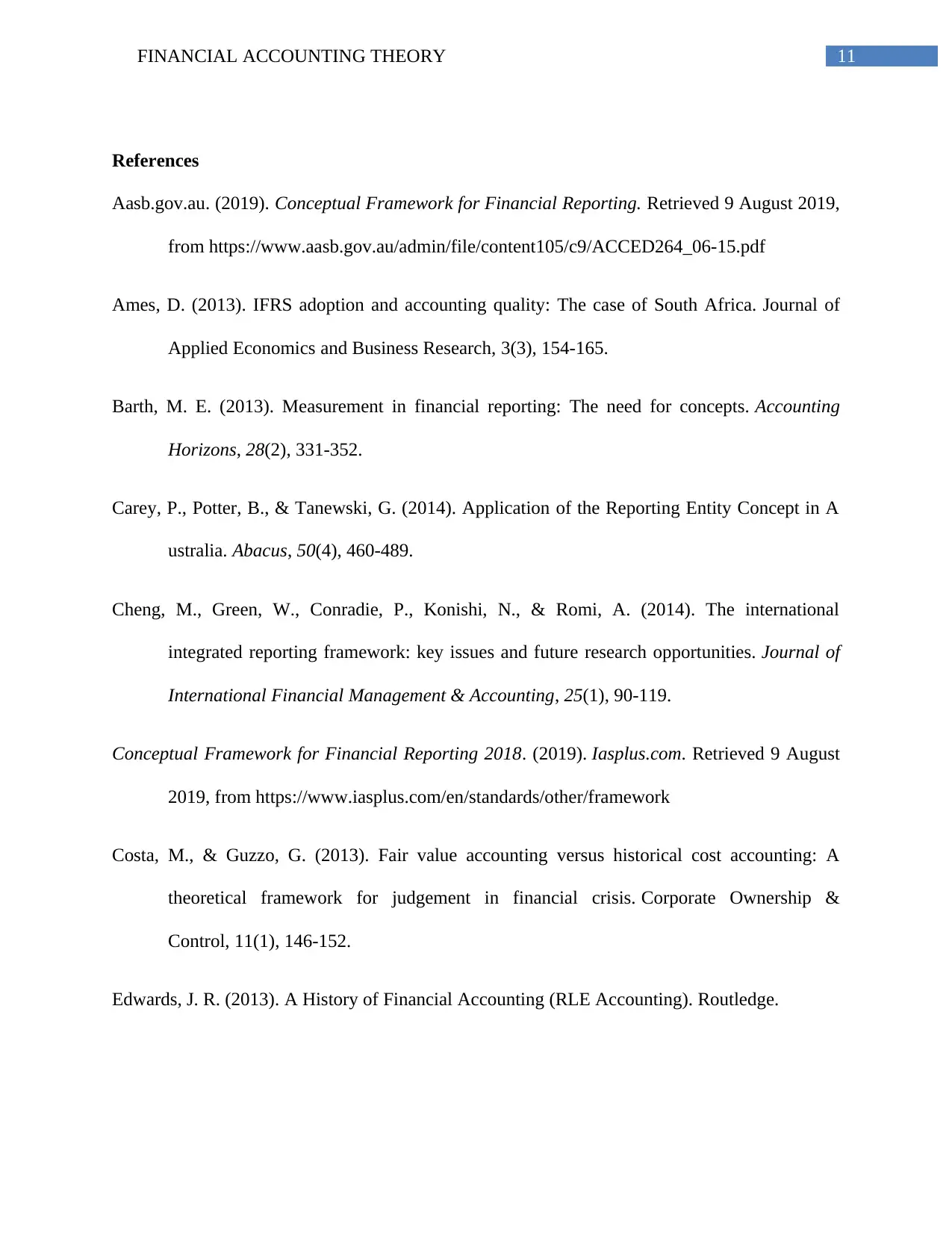
11FINANCIAL ACCOUNTING THEORY
References
Aasb.gov.au. (2019). Conceptual Framework for Financial Reporting. Retrieved 9 August 2019,
from https://www.aasb.gov.au/admin/file/content105/c9/ACCED264_06-15.pdf
Ames, D. (2013). IFRS adoption and accounting quality: The case of South Africa. Journal of
Applied Economics and Business Research, 3(3), 154-165.
Barth, M. E. (2013). Measurement in financial reporting: The need for concepts. Accounting
Horizons, 28(2), 331-352.
Carey, P., Potter, B., & Tanewski, G. (2014). Application of the Reporting Entity Concept in A
ustralia. Abacus, 50(4), 460-489.
Cheng, M., Green, W., Conradie, P., Konishi, N., & Romi, A. (2014). The international
integrated reporting framework: key issues and future research opportunities. Journal of
International Financial Management & Accounting, 25(1), 90-119.
Conceptual Framework for Financial Reporting 2018. (2019). Iasplus.com. Retrieved 9 August
2019, from https://www.iasplus.com/en/standards/other/framework
Costa, M., & Guzzo, G. (2013). Fair value accounting versus historical cost accounting: A
theoretical framework for judgement in financial crisis. Corporate Ownership &
Control, 11(1), 146-152.
Edwards, J. R. (2013). A History of Financial Accounting (RLE Accounting). Routledge.
References
Aasb.gov.au. (2019). Conceptual Framework for Financial Reporting. Retrieved 9 August 2019,
from https://www.aasb.gov.au/admin/file/content105/c9/ACCED264_06-15.pdf
Ames, D. (2013). IFRS adoption and accounting quality: The case of South Africa. Journal of
Applied Economics and Business Research, 3(3), 154-165.
Barth, M. E. (2013). Measurement in financial reporting: The need for concepts. Accounting
Horizons, 28(2), 331-352.
Carey, P., Potter, B., & Tanewski, G. (2014). Application of the Reporting Entity Concept in A
ustralia. Abacus, 50(4), 460-489.
Cheng, M., Green, W., Conradie, P., Konishi, N., & Romi, A. (2014). The international
integrated reporting framework: key issues and future research opportunities. Journal of
International Financial Management & Accounting, 25(1), 90-119.
Conceptual Framework for Financial Reporting 2018. (2019). Iasplus.com. Retrieved 9 August
2019, from https://www.iasplus.com/en/standards/other/framework
Costa, M., & Guzzo, G. (2013). Fair value accounting versus historical cost accounting: A
theoretical framework for judgement in financial crisis. Corporate Ownership &
Control, 11(1), 146-152.
Edwards, J. R. (2013). A History of Financial Accounting (RLE Accounting). Routledge.
⊘ This is a preview!⊘
Do you want full access?
Subscribe today to unlock all pages.

Trusted by 1+ million students worldwide
1 out of 14
Related Documents
Your All-in-One AI-Powered Toolkit for Academic Success.
+13062052269
info@desklib.com
Available 24*7 on WhatsApp / Email
![[object Object]](/_next/static/media/star-bottom.7253800d.svg)
Unlock your academic potential
Copyright © 2020–2025 A2Z Services. All Rights Reserved. Developed and managed by ZUCOL.





